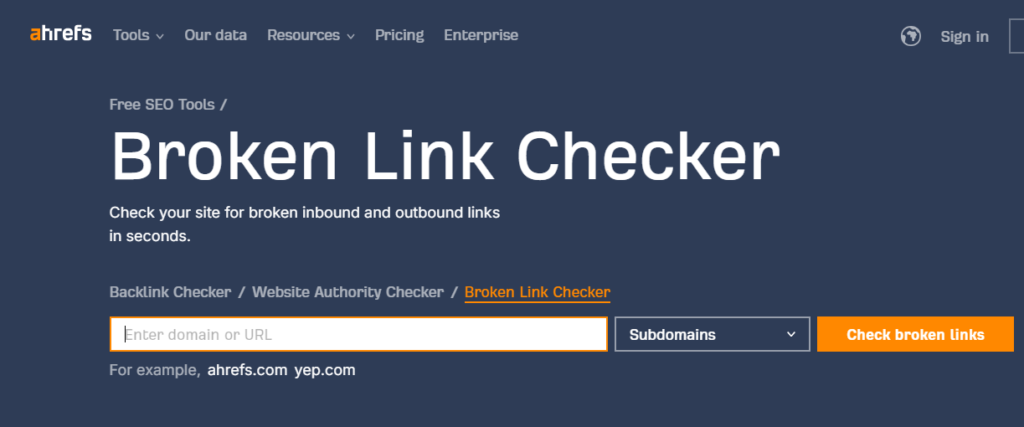In the vast landscape of the internet, broken links are an inevitable nuisance that can hamper user experience, hinder website credibility, and impact search engine optimization (SEO). From brokenlink checkers to effective strategies for detection and resolution, mastering the art of handling broken links is crucial for website owners and managers. In this article, we delve into what broken links are, their consequences, and methods for both identifying and rectifying them.
What are Broken Links?
Broken links, also known as dead links or dangling links, refer to hyperlinks that no longer lead to their intended destination. Instead, they result in a 404 error message or a similar indication that the requested page cannot be found. These links may occur due to various reasons, including but not limited to:
- Page Removal: The linked page has been permanently deleted or moved without proper redirection.
- URL Changes: The URL structure of the destination page has been altered, rendering the existing links obsolete.
- Server Issues: Temporary or permanent server downtime prevents access to the linked content.
- Typographical Errors: Manual input errors in hyperlink creation lead to incorrect URLs.
Consequences of BrokenLinks
The presence of broken links can have detrimental effects on both website performance and user satisfaction. Some notable consequences include:
- Negative User Experience: Encountering dead links frustrates visitors, potentially leading to decreased engagement and loss of credibility.
- SEO Impacts: Search engine crawlers interpret broken links as a sign of poor website maintenance, potentially resulting in lower search rankings.
- Lost Opportunities: Broken links diminish the effectiveness of internal and external linking strategies, reducing referral traffic and conversion opportunities.
How to Find Broken Links
Several tools and techniques are available to identify broken links effectively:
- Broken Link Checkers: Utilize specialized online tools or plugins that automatically scan websites for broken links. Examples include Dead Link Checker, W3C Link Checker, and Google Search Console’s URL Inspection Tool.
- Manual Inspection: Periodically review website content, verifying the functionality of hyperlinks manually.
- Crawl Reports: Analyze website crawl reports generated by search engine optimization tools like Screaming Frog or SEMrush to pinpoint broken links systematically.
To check for broken links using Ahrefs, follow these steps:
- Log in to Ahrefs: Visit the Ahrefs website and log in to your account using your credentials.
- Enter Your Domain: Once logged in, enter the domain of the website you want to check for broken links into the search bar at the top of the Ahrefs dashboard.
- Navigate to Site Explorer: After entering the domain, click on the “Site Explorer” option from the menu.
- View the Overview: In the Site Explorer, you’ll see an overview of your website’s performance metrics. Look for the “Outgoing Links” section, which provides insights into the links present on your website.
- Click on “Outgoing Links”: Click on the “Outgoing Links” section to expand it and reveal more options.
- Select “Broken Links”: Within the “Outgoing Links” section, you’ll find a subsection labeled “Broken Links.” Click on this option to view a list of broken links present on your website.
- Analyze Broken Links: Ahrefs will generate a list of broken links found on your website, along with details such as the referring page, anchor text, and HTTP status code (e.g., 404 Not Found). Review this list to identify the broken links that need attention.
- Take Action: Once you’ve identified the broken links, take appropriate action to fix them. This may involve updating the URL, setting up redirects, or removing the broken links altogether.
- Monitor Regularly: Make it a habit to regularly check for broken links using Ahrefs to ensure that your website maintains optimal performance and user experience.
By following these steps, you can effectively use Ahrefs to check for and address broken links on your website, ultimately improving its overall quality and usability. There is a also Short way to check broken links through Ahref just click here and visit the page.

Checking for broken links using other tools is straightforward and can be done using various online services and software. Here’s a general guide on how to check for broken links using alternative tools:
1. Online Broken Link Checkers:
- Dead Link Checker: Visit the Dead Link Checker website and enter the URL of the website you want to check. The tool will scan the website and provide a list of broken links.
- W3C Link Checker: Access the W3C Link Checker tool online and input the website URL. It will analyze the website’s links and report any broken ones found.
2. Google Search Console:
- Log in to your Google Search Console account.
- Navigate to the “Coverage” report under the “Index” section.
- Click on “Excluded” to filter the report.
- Look for any URLs labeled as “404 (Not found)” or “410 (Gone)” to identify broken links.
3. Screaming Frog SEO Spider:
- Download and install the Screaming Frog SEO Spider software.
- Enter the website URL in the input field.
- Once the crawl is complete, go to the “Response Codes” tab to filter URLs with 404 or other error codes, indicating broken links.
4. Online Website Crawlers:
- Use online website crawlers such as Sitechecker or SEOptimer.
- Enter the website URL to initiate the crawling process.
- These tools will provide detailed reports, including broken links found during the crawl.
5. Browser Extensions:
- Install browser extensions like Check My Links (for Google Chrome) or Link Checker (for Firefox).
- Open the webpage you want to check and activate the extension. It will scan the page and highlight any broken links.
6. Manual Inspection:
- While less efficient for larger websites, manually checking for broken links can still be effective for smaller sites.
- Simply navigate through the website’s pages and click on each link to verify if they lead to the intended destination.
Once you’ve identified broken links using any of these methods, take necessary actions to fix them, such as updating URLs, setting up redirects, or removing the broken links altogether. Regularly checking for and addressing broken links helps ensure a smooth browsing experience for visitors and maintains the overall health of your website.
How to Fix Broken Links

Once broken links are identified, the following steps can be taken to address them:
- Update or Replace URLs: Locate the correct URL of the intended destination and update the broken link accordingly.
- Implement 301 Redirects: If the linked page has been permanently moved, set up a 301 redirect to automatically direct users to the new URL.
- Remove or Rewrite Links: If the linked content is no longer available or relevant, consider removing the broken link altogether or replacing it with an alternative resource.
- Monitor Regularly: Establish a routine for monitoring and addressing broken links to maintain a seamless browsing experience for visitors.
In conclusion, broken links pose significant challenges for website owners and administrators, but with the right tools and proactive approach, they can be effectively managed. By understanding the causes of broken links, employing appropriate detection methods, and implementing timely corrective measures, websites can uphold their credibility, enhance user experience, and bolster their SEO performance.
Elevate your website’s authority with our expert insights on Link Building and White Hat link building techniques. Explore the power of quality backlinks.

